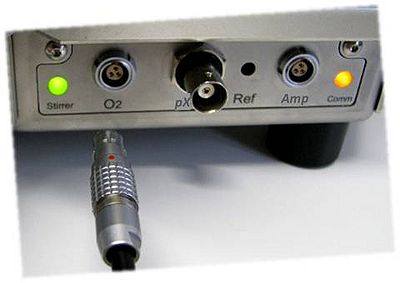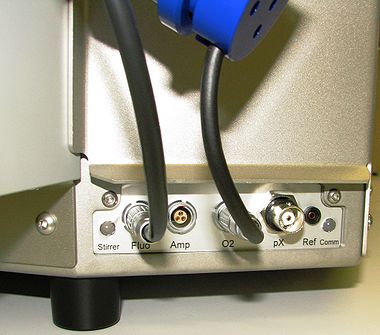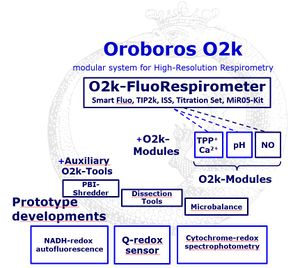From Bioblast
Description
Three electronic channel types are available in the O2k-MultiSensor system. All channels are available twofold (dual-data), for O2k-Chambers A (left) and B (right), based on numerical signals sent at a fixed data sampling time interval (default: 2 s; range 0.2 s to >10 s).
Reference: O2k-Catalogue: O2k-MultiSensor
O2k signals
- 1. O2 channel with electric current (ampere [A]) as the primary signal, which is converted to a voltage (volt [V]) the raw signal. The O2k-FluoRespirometer supports not only the O2 channel (O2 plug), but also the channel types 2 and 3 for the add-on modules.
- 2a. Fluo channel: The Fluo sensor has electric current (ampere [A]) as the primary signal, which is converted to a voltage (volt [V]) as the raw signal. Therefore, the O2k-Fluo LED2-Module is connected to the Amp plug (up to O2k-Series G) or the Smart Fluo-Sensors are connected to the separate Fluo plug (O2k-Series H upwards).
- 2b. Amp channel: The amperometric channel of the O2k (Amp plug), has electric current (ampere [A]) as the primary signal, which is converted to a voltage (volt [V]) as the raw signal. The Amp channel is used with the O2k-NO Amp-Module. Up to O2k-Series G, the Amp plug is also used with the O2k-Fluo LED2-Module. Electronically, 2a and 2b are the same channel.
- 3. pX channel with electric potential (volt [V]) as the primary potentiometric raw signal (BNC pX plug for the ion sensitive electrode, ISE; and separate plug for the pX reference electrode, Ref).
O2k-Innovation: additional channel types are available in the O2k-Innovation:
- 4. Dual-fluo channel.
- 5. Spectrophotometric channel.
- System channels, for instrumental control and monitoring experimental conditions for both O2k-Chamber A and B (single-data). The numberical signals are sent at the same fixed data sampling time interval:
- 6a. Block temperature: Measured block temperature equivalent to the experimental temperature in the O2k-Chambers at steady state [°C].
- 6b. Peltier power (system channel): Relative heating or cooling power of the Peltier system.
- 6c. Barometric pressure (system channel): Measured barometric pressure [kPa].
- 6d. Ambient temperature (system channel): Measured temperature of room air (O2k-Series G upwards) [°C].
- 6e. External temperature (system channel): Temperature measured with an independently placed thermistor (O2k-Series G upwards) [°C].
- Events carry information on a time point during the experiment, a short event name (text), and a longer string of comments (text):
- 7. Events: Automatic events (e.g. from the TIP2k) and manually triggered events.
O2k output
- The 'output' of a channel is the finally important information, which may be summarized in a data base.
- Calibrated signals and derived plots: Three types of output can be derived from the signal of the channels supported by the O2k and displayed as separate plots:
- I: Concentration. Examples: O2; Ca2+; concentration is amount of substance per volume [1 µM = 1 µmol·dm-3 = 1 nmol·mL-1].
- II: Flow, flux, rate. Examples: O2 consumption; H2O2 production; volume-specific flux is the negative or positive time derivative of concentration over time, frequently multiplied by 1,000 [pmol·s-1·mL-1]. Volume-specific flux normalized for the cell density [106·ml-1] is flow [pmol·s-1·mL-1]. Volume-specific flux normalized for the mass density of the sample in the O2k-Chamber [mg·mL-1] is mass-specific flux [pmol·s-1·mg-1]. Flux in any respiratory state normalized for flux in a defined reference state is a rate [dimensionless] or flux control ratio.
- III: Force, potential. Examples: TMRM, Safranin and Rhodamine 123 for mt-membrane potential; redox potential from redox states of cytochromes or NADH .
- O2k-Modules - applications and output signals
- 1. O2 channel - all O2k configurations: Output type I and II.
- 2a. Fluo (Amp) channel - O2k-FluoRespirometer and O2k-Fluo LED2-Module: The focus of the output depends on the specific fluorophore. Output type I, II, or III, or any combination may relate to the primary level of interest.
- 2b. Amp channel - O2k-NO Amp-Module: Output type I and II.
- 3a. pX channel - O2k-TPP+ ISE-Module: Output type III.
- 3b. pX channel - O2k-pH ISE-Module: Output type I and II.
- Additional output types for the O2k-Innovation
- 4. Single-fluo channel - O2k-Innovation: Plots of one selected wavelength can be selected for recording. Output type I(1), II(1), III(1) depends on the fluorophore.
- 5. Dual-fluo channel - O2k-Innovation: Plots of two selected wavelengths can be selected for simultaneous recording. Output type I(2), II(2), III(2) depends on the fluorophore.
- 6. Spectrophotometric channel - O2k-Innovation: Output type IV (three plots for redox states of cytochromes aa3, b, and c).
- IV: Redox states.
- V: Pre-calibrated signals for system channels.
- VI: Events.
MitoPedia O2k and high-resolution respirometry:
O2k hardware,
DatLab



